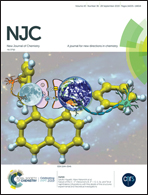A simple and sensitive electrochemical sensor with A-PCA film modified electrode for the determination of metanephrine
Abstract
A new electrochemical sensor was fabricated for the sensitive and selective detection of metanephrine (MN), based on a glassy carbon electrode (GCE) acidified by sulphuric acid and using an electrodeposition method to form poly caffeic acid (PCA) films. Adding the electrochemical pretreatment to acidify the GCE was conducive to an increase of surface concentrations of C–O functional groups and generation of a rough surface on the modified electrode. Furthermore, the PCA films developed on the GCE surface were advantageous to the significant increase in the electrode surface and more active sites, thus improving the electrocatalytic activity. The proposed electrochemical sensor exhibited high sensitivity, stability and selectivity towards MN. The surface morphology of the acidified poly(caffeic acid) modified GCE (A-PCA/GCE) was characterized by scanning electron microscopy (SEM) showing that the surface of the electrode possesses a rod like structure. Under optimal conditions, the sensor showed a liner proportional response to MN in a wide determination range from 0.5 to 40.0 μM with a detection limit (S/N = 3) of 0.17 μM. Finally, the fabricated sensor was also successfully applied to detect MN in human serum samples, and satisfactory recoveries were obtained.



 Please wait while we load your content...
Please wait while we load your content...